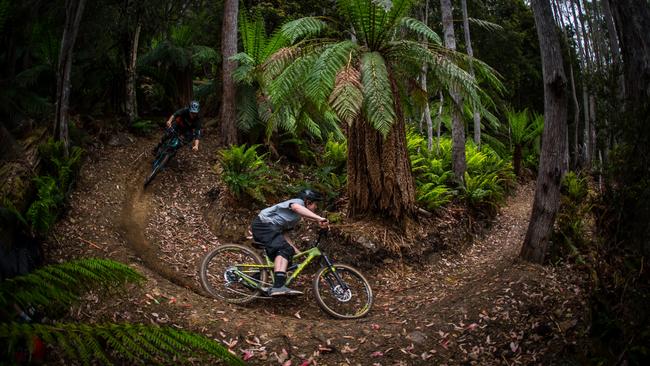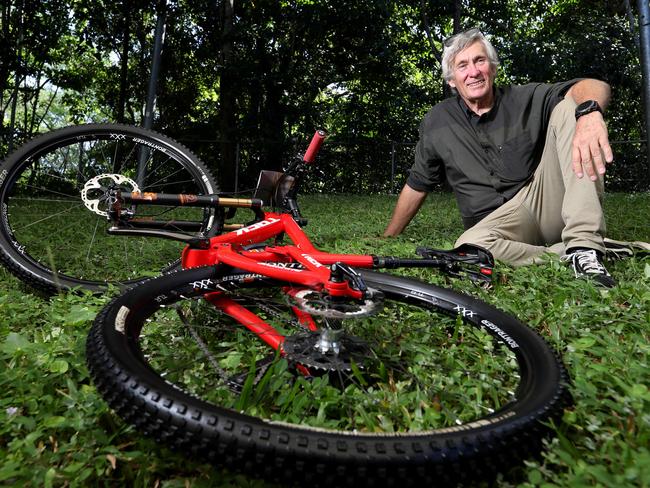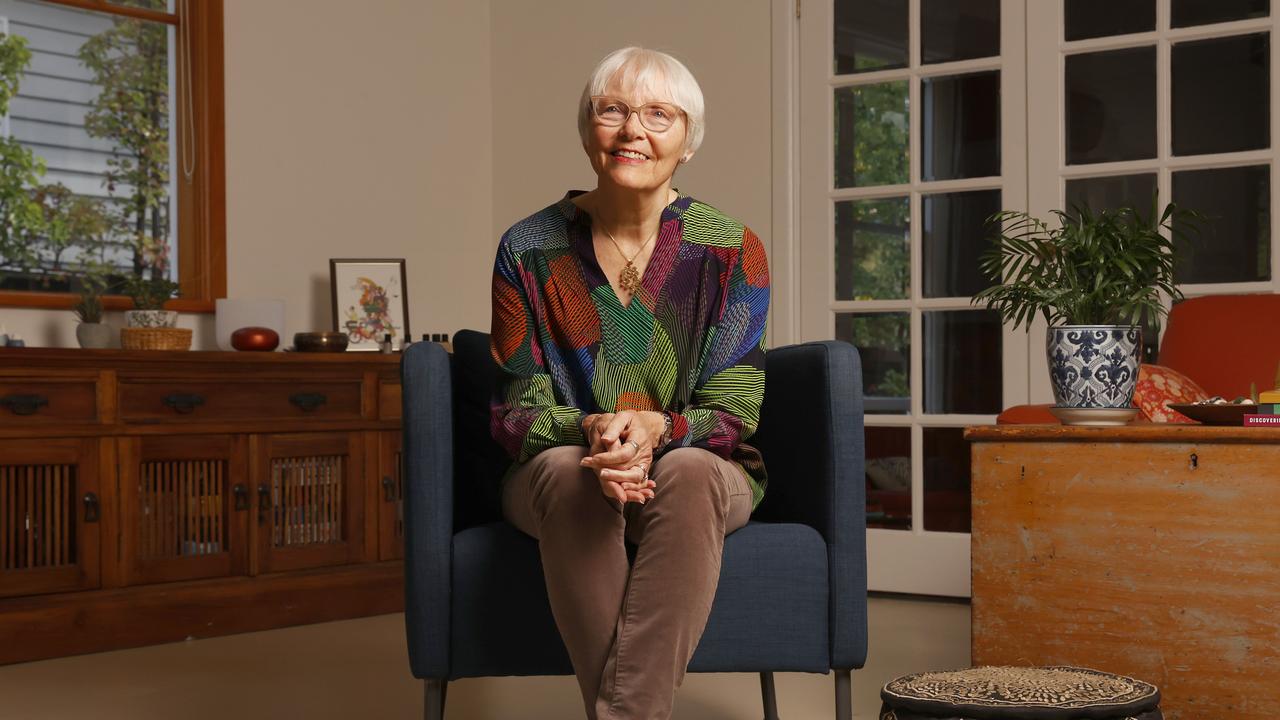TasWeekend: Two-wheeled wonders driving tourism boom in regional Tasmania
Five years ago, Derby was a ghost town. Now it hosts up to 1000 tourists a night – and it is all thanks to two wheels.

Lifestyle
Don't miss out on the headlines from Lifestyle. Followed categories will be added to My News.
NORTHERN Tasmania’s Blue Derby mountain bike trail officially opened only three years ago — and already it has hosted two Enduro World Series events and a number of smaller comps. The construction of the $2.9 million, 80km Derby trail network changed the North-East Tasmanian community from ghost town to boom town virtually overnight, creating about 100 new jobs, leading to an influx of tourism and a new local economy built around bike shops and hospitality.
The Dorset Council estimates visitors to the Blue Derby network, comprising trails from Derby to the Blue Tier, have pumped more than $30 million into the state’s economy since it opened — $12 million of that going directly to Dorset.
Before Blue Derby opened, mountain biking tourism accounted for 27,899 people a year. In the 2017-18 financial year that figure soared to 46,260. There is no doubt there is good money in mountain bike tourism and, following Derby’s remarkable transformation, St Helens on the East Coast is set to start reaping the same rewards.
The 43km Bay of Fires Descent is set to open to riders on November 22, the new trail linking with the existing Blue Derby network, allowing riders to continue from the Blue Tier all the way down to the internationally famed beach of the Bay of Fires, and on to the new 66km Stacked Loop network of trails at nearby St Helens.

Needless to say, Break O’Day Mayor Mick Tucker is extremely excited about the town’s future. “People are already booking in to come and stay here while they do the ride,” he says. “Jobs are already being created, shuttle bus companies are being set up, booking offices; everything is going mad, the investment coming in here is mind-blowing.”
St Helens does have a significant head start over Derby in one respect, in that it is already a well-established tourism hot spot. The state’s East Coast is a highly sought after tourist destination, and is already well-resourced in terms of accommodation, restaurants, service stations and other essential infra-structure. And this tiny coastal town hit the national spotlight in a massive way a year ago when it was chosen to host Triple J’s annual free music festival, One Night Stand, which attracted a staggering 20,000 concertgoers. Thousands more were turned away at the gate, making it the best crowd in the event’s history.
St Helens has not shied away from capitalising on this new-found attention, and the addition of these new mountain bike trails marks St Helens’ entry into an industry that is rapidly becoming one of the state’s most important.
Tourism Tasmania data shows that in the 12 months to June 2019, 25,417 visitors to Tasmania went mountain biking while they were here, staying an average of 14 nights and spending an average of $2634 each, representing an injection of around $67m into the state’s economy.
It is no wonder St Helens is keen to get in on the action.
“We are the action-packed capital of Tassie,” Tucker says. “You can go game fishing, mountain biking, golfing, walking on the beaches, surfing; there’s a multitude of things to do if you stay here and this is giving people one more reason.
“In a normal summer period the population of St Helens goes from 3000 up to about 15,000 or even more, and I expect we will see that only increase from here.”
“The Blue Tier to Bay of Fires descent is the last stage in the Blue Derby network — and it will be iconic. It starts in the subalpine altitude and finishes at zero altitude, at the beach, the Bay of Fires, which has been featured by Lonely Planet twice now, and was named the best beach in the world. That’s unique.”

And just to ensure a cracker of an opening for the new trail, two days before the official opening of the descent, Derby will host this year’s Australian Mountain Bike Summit, where representatives of state governments and municipalities from around Australia will hear from local business operators, world class track designers and community leaders about how this corner of Tasmania turned a sport into a new industry.
Colin Lester, owner of St Helens sporting goods store East Lines, is at the front line of the expected two-wheeled invasion of the town and he is champing at the bit. He says he has already seen an increase in biking visitors since Blue Derby opened and expects it to only get bigger.
“There are definite, visible benefits,” he says. “We’re seeing more bikes around town and on the back of cars. Even though some tracks aren’t even open yet, word is clearly out that this is the place to go.
“We already have that great flow-on from Derby because people who come to Tassie to ride Derby end up staying on in Tassie and visiting other trails and tracks all over the state. A lot of them even stay in St Helens and base themselves from here to do Blue Derby.
“We have a great bike track along St Georges Bay already, and people flock to that, riding in families, so it’s already an attraction here. And in the last couple of years we’ve seen a big increase in the number of people coming in here to buy spare tubes, lube, asking for advice; and after riding the existing tracks they’re coming here to ask where else they can go to do more.”

Lester’s shop, a local institution, is the only sporting goods shop in St Helens at the moment, but that is all about to change as well.
“There are three other bikes shops opening up in St Helens, I can see them getting ready,” he laughs. “But they say competition is healthy, right? And really, it is a great sign for the place, seeing that kind of confidence and optimism, it’s fantastic.”
Tucker says his dream is to see St Helens become a mountain biking hub in the region.
“Between Derby and St Helens there will be about 250km of track in total, all linked, and it will take a week to ride it all, so we hope people will stay in St Helens while they do it. Every one of those trails has something different to offer, all different difficulty levels, all the different styles and scenery. Each trail will be seen as a must-do because each one is so unique.”
He hopes the East Coast’s famously good weather will become both a selling point and a practical advantage for visiting riders.
“On the East Coast, unless there’s a major flood, you can still ride the trails in pretty much any weather. The soil drains really well and because of the terrain water tends to wash away quickly. Even in midwinter the temperature here during the day sits on about 15 degrees, which is much more attractive than other parts of the state in the cold months.
“And then in the summer, can you imagine starting that descent trail high up in the Blue Tier and jumping into the waters of the Bay of Fires to cool off at the end of the ride?”
And Lester is excited to ride the new track for himself.
“I’m a cruising mountainbiker, myself, so that descent will be fantastic for me and my family. We do the old Gardens Road as a family. My kids are in their 20s and they all ride too. I’ve done a couple of the Derby tracks and the new one is definitely on my itinerary!”

Over in Derby, essentially ground zero for Tasmania’s mountain biking boom, Dorset Council general manager Tim Watson is still pinching himself over the change the region has experienced since hitting the world stage with its internationally renowned Blue Derby trails. “We have seen a massive amount of investment in Derby in the last few years, new accommodation and new buildings,” Watson says.
“One hundred beds have come online in Derby in the last six months of this calendar year alone as a result of that investment.
“And it isn’t just visitors to the state, either. Derby has become a holiday destination for Tasmanians as well.
“We have hundreds of people there over every long weekend now, and that’s on top of the constant stream of interstate visitors, and it has been consistent since the day the trails opened.”
Watson says Derby was a ghost town five years ago, in terminal decline like many regional and remote Tasmanian towns that have found themselves without an industry to rely on.
He says a lot of the working families left the town simply because they needed to seek employment elsewhere, which steadily sucked the life out of what remained of Derby. He described the town’s revival as nothing short of a miracle — and says it is an example other towns in similar peril can look up to.
“None of this is an accident, it has been the result of careful planning. Our trails were designed by world-class designers.
“We wanted them to be the best in the world, and now they are attracting the best riders in the world.
“In peak periods we have as many as 1000 people staying in the town now, and so many new businesses have sprung up to support the mountain bike industry, new families are moving back in again.
“We’ve had babies born in the town for the first time in 20 or 30 years.”
Tara Howell is part of that new rush of energy coursing through Derby, having established a boutique tourism experience that piggybacks off the Blue Derby trails.
The Blue Derby Pods Ride has been described as the Three Capes Walk of riding, allowing visitors to ride the trails, enjoy fully catered meals, and stay overnight in luxury architecturally designed “pods” in the forest overnight in between rides.

Howell says that not only has the boom been remarkable so far, it is showing no signs of slowing down.
“Interest in the sport is growing and getting broader. In the past it was seen as this hardcore sport that only a certain type of person would be able to do, but now we are seeing a lot more people of all abilities taking it up, and we get a lot of families.”
She says Derby hosting the Enduro World Series in 2017 — the first time the event had been hosted in Australia — marked the start of a huge revolution.
“When we were starting out, we had to tell story of Derby to people who had never heard of it. But now we don’t have to tell the story; people know it already, and that’s why they’re coming here.
“Last season 90 per cent of our visitors were from mainland Australia, five per cent were Tasmanian and five per cent were from overseas, mainly from the US and UK.
“We are blessed here with this incredible landscape that people already come from all over the world to see, and this is just another way for people to see and experience it.
“And providing the kind of experience we do just taps into another aspect of the sport. A few decades ago, bushwalking in Tasmania was seen as a dangerous and extreme hobby that only the really hardcore enthusiasts would do.
“Then you got things like the Overland Track opening up, and suddenly you have people of all experience levels giving it a go, and all the tourism experiences that have sprung up around that, so we see mountain biking going exactly the same way.”
Derby also seems to have become the national exemplar of how to create this type of industry.
The Australian Mountain Bike Summit on November 19-20 will feature such luminaries as Glen Jacobs, director of World Trail, the world-class mountain bike trail designer who designed the Blue Derby and St Helens trails, and Hans Rey, a former trails World Champion and inductee of the Mountain Bike Hall of Fame, who now travels the world seeking out riding locations that are both historic and hold a sense of mystery.
“There are a great many mountain bike trail proposals around Australia at the moment, all up and down the eastern seaboard,” Howell says.
“They are all investing huge amounts of money to get involved in this booming area — and Derby is the example they are all looking towards for inspiration.”

Tourism Tasmania spokeswoman Edwina Morris says the success of Derby and St Helens is a great example of regional towns diversifying their economies and breaking into the tourism industry for themselves.
“What’s really remarkable about those places is how much these projects were driven by the local councils,” she says. “They represent regional towns really making that effort to reinvent themselves and becoming something amazing.
“Mountain Biking is a key part of Tourism Tasmania’s Unordinary Adventures program to target people who travel to pursue their passions, specifically in the areas of mountain biking, golf, fly fishing and bush walking.
“Tasmania has this critical mass of experiences for people in those areas and all of them are world class.”
It isn’t all about the North-East, though. Mountain biking is flourishing all over Tasmania.
The Oonah Hill Track opened earlier this month, the first of a number of planned mountain bike trails on the West Coast, and then there is the extensive network of trails and tracks around the greater Hobart area, including the popular Meehan Range trail on the eastern shore, and numerous rides around kunanyi/Mt Wellington, including the North-South Track and the Pipeline Track.
These Hobart trails are well established, but even they are experiencing an explosion of interest coming off the back of the Blue Derby network. People who visit the state to ride at Derby almost invariably stay on to visit other parts of Tasmania, often aiming to ride as many trails as they can in the state — and eventually head south.
“We are definitely seeing a noticeable increase of visitors coming through to ride,” says Chris Riley, owner of Ken Self Cycles in Hobart.
“Especially over the summer, we get way more tourists coming in to buy tubes and brake pads, that sort of thing. They might be on their way through to Derby or Maydena and are sampling the Meehan Range and the mountain first.”

Riley says he would love to see Hobart’s trail network reach the same standard as those in the north and east, and eventually be part of that world class circuit, but he is happy to wait and see the development done well, not rushed.
“All this international attention is great news for us, but this stuff needs to be done properly,” he says.
“The Clarence City Council has made a serious commitment with the Meehan Range trail and professional trail builders have done some great work over there recently. Meehan Range took some pressure off the mountain; the small amount of infrastructure up there was getting hammered.”
Tucker does not think Tasmania has quite reached mountain biking Mecca status just yet, but he thinks we are very close.
“We are definitely nearly there. We certainly offer something unique here. You can go out into virgin bush and explore the scenery as you ride, and the landscape here is something so many people have never seen before.
“And it is an all-year-round industry. When it’s too hot to ride on the mainland, people will come here. And in the winter, the East Coast is still mild compared to other places, so we will still have that appeal.
“We don’t mind if it’s a surf board or a bike in the hotel room, as long as there are people in those rooms all year.”
Lester agrees the Blue Derby network is a feather in the state’s cap, but he says we need to keep making it even better and find new ways to capitalise on our growing international reputation.
“Tassie is just such a great state for cycling in general — road cycling as well as mountain biking. We should really make more of that, I think.
“Imagine if we made it free for people to bring their bike over on the ferry, putting all those cyclists onto the roads and trails instead of cars.
“We are the perfect place for cycling tourism. The towns are all so close together in Tassie, if it starts raining, you’re only ever 20 minutes from somewhere where you can get off the road and go inside for a coffee or something.
“We have something special here, the current boom proves that. We need to keep making it work for us.”


